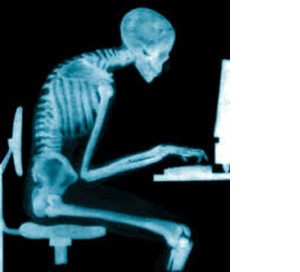When you’re at work you often times don’t have the option of choosing whether you can sit or stand all day. If you’re lucky enough to be able to choose, it’s important to know which one will benefit you more. Office environments oftentimes have a lot of sitting employees for an extended period of time, while cashiers, tellers, and other professions, usually in the vein of retail, see employees standing for long periods of time.
With the “invention” of ergonomic desks, it may seem enticing to get a standing desk. Manufacturers of these desks often boast about the health benefits of standing in your workplace as well as the hazards of sitting. While it may seem like a good idea to stand at your desk, both too much standing and too much sitting can have some major effects on your health.
Sitting in the Office
 Your job may involve sitting in a cubicle behind a computer screen for hours at a time. Studies have shown that sitting for extended periods of time repeatedly can lead to disability later in life. While we’ve all heard of the dangers of sitting too much, it doesn’t mean that sitting is necessarily a bad thing.
Your job may involve sitting in a cubicle behind a computer screen for hours at a time. Studies have shown that sitting for extended periods of time repeatedly can lead to disability later in life. While we’ve all heard of the dangers of sitting too much, it doesn’t mean that sitting is necessarily a bad thing.
The problem is much of our lifestyle involves sitting. On your commute to work you sit the whole time. If you work in an office setting, you may sit for up to eight hours a day completing your work. When you get home, relaxing may involve sitting on the couch to watch television or play video games. This means that most of your day you spend sitting, which can cause a variety of problems. Sitting too much can increase your risk of heart disease, diabetes, cancer, and obesity.
Mitigating “Sitting Disease”
“Sitting disease” is a term coined by the scientific community to describe a sedentary lifestyle. Sitting disease is not a real disease and is not diagnosable at this time by the medical community. What this means is that “sitting disease” is a term to describe a variety of symptoms that are brought on by or aggravated by elongated periods of sitting.
You may start feeling restless after a long period of sitting. This is your body telling you to get up and move! Sitting too long can be detrimental to your health, but so can standing. Optimally, you want to be doing movement rather than varying your sitting-standing routine. While standing when taking a phone call may help reduce your sitting, burn extra calories, and strengthen your heart, you want to move around more than just switch between sitting and standing.
- Take a few minutes out of your office day to begin some stretches. You can see a detailed description of some office stretches you can do to help your body when you’re faced with long periods of stretching.
- Move around more. Take those trips to the water cooler, or instead of sending an email to your coworker, walk the distance down to their cubicle or office. Try to make an attempt to vary what you’re doing.
- Rethink your commute. If you’re within distance to walk somewhere for your lunchbreak, or even to bike or run to work, you can cut down your sitting time easily as well as save yourself some money on gas. Cutting out a 20 minute roundtrip commute every day where you’re sitting amounts to 100 minutes a week (or more) you’re being active and saving yourself from sitting.
Stay tuned for Part 2 on how to stay healthy when your job involves excessive standing.
